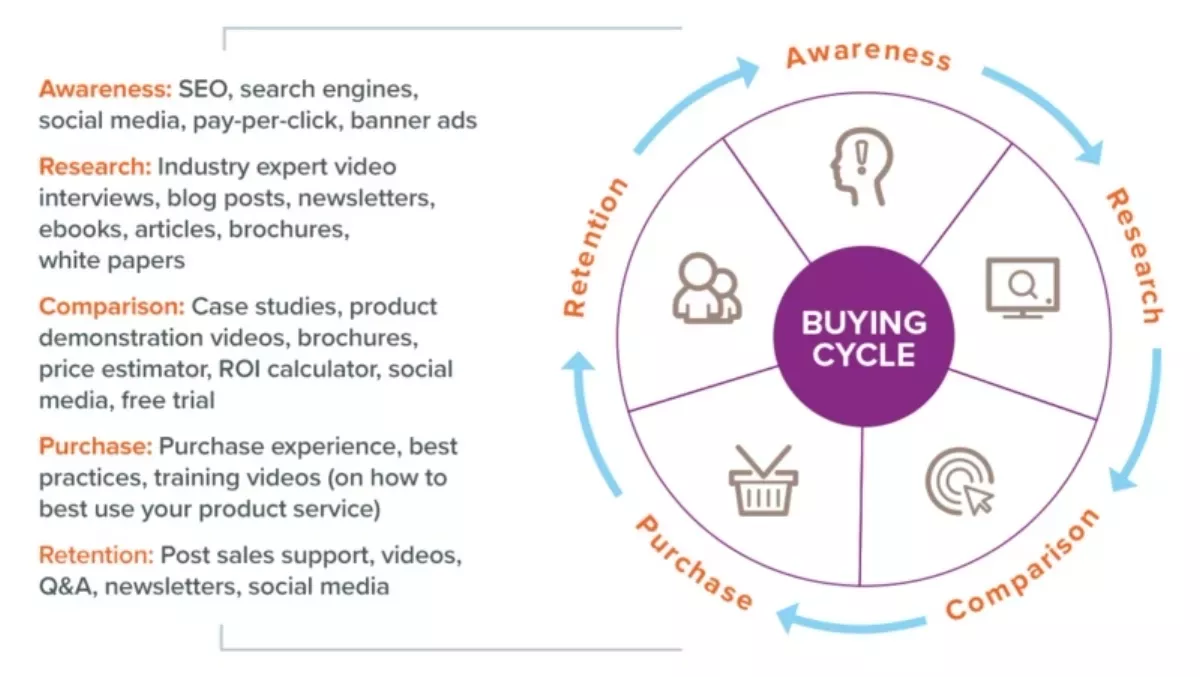
B2B marketing: Solving the big five challenges
Let's face it, as a B2B tech company, marketing isn't easy.
With typically longer sales cycles, multiple key stakeholders involved in every decision, fierce competition within the industry, and many B2B businesses selling complex solutions rather than single products, B2B tech marketing is… well, it's complicated. But it's not impossible.
To help you succeed, we've broken down 5 of the most common marketing challenges faced by B2B tech businesses today, and how you can solve them.
B2B tech: it's a fast-paced industry
With the tech industry evolving so fast, marketers need to be agile; pivoting quickly and adapting effectively when faced with changes or growing competition within the market.
To stay on the leading edge of the industry, be sure to keep your ear to the ground at all times. This means keeping an eye on your target market and your competition, and monitoring reputable sources for any announcements, opportunities or potential threats to your brand.
Changes within the market can present a real problem for businesses who aren't paying attention. But they can be a boon to brands who are prepared to change and adapt.
Sometimes being just a little quicker than the competition may be all you need. For example: being the first to start talking about a rising trend or new cutting edge technology may help your brand define itself as a thought leader in your industry.
Spotting where a competitor is late to the game or has an imperfect solution in market may present a valuable opportunity to offer a more immediate or superior solution that fills a recently-highlighted gap in the market. The tech industry is moving fast, and you'll need to move with it in order to thrive.
Marketing to multiple stakeholders over time
For many years it's been said that there are an average of 6.8 key stakeholders involved in the decision-making processes within a business. However, recent studies have indicated that this number is now closer to 8.2.
Faced with such a complex decision-making process, marketers can find it challenging to get in contact with all of these key stakeholders and communicate with them in a meaningful way.
After all, not every decision-maker is coming to your product or solution from the same perspective, and generic advertising just isn't going to cut it. Your communication needs to be carefully crafted to suit the individual's position, interests, needs and goals within the business.
Start by creating detailed and accurate buyer personas to ensure that your content is carefully targeted and speaks to each stakeholder on a more personal level.
In the B2B setting, it's also important to remember that making a sale typically takes much longer than when selling direct to the consumer. Be patient and make sure to continue maintaining the relationship, even after the sale has been made. This will encourage customers to remain loyal to your brand in the years to come.
You're in it for the long haul!
Standing out from the crowd and demonstrating value in a saturated market
The B2B tech industry is fiercely competitive. In such a saturated market, sometimes it can be hard to stand out from the crowd and demonstrate value. That's why you'll need to conduct regular and in-depth market research to uncover any opportunities within your industry:
- Find the channels that customers are spending the most time on.
- Discover the conversations customers are having
- Learn about the latest trends
- Note the questions that customers are asking
- Uncover the problems that customers face
Once you understand where your customers are and what they need, you can begin engaging in those conversations on the right platforms, and tailoring your marketing efforts towards answering those questions and solving those key problems.
Make yourself a thought leader in your industry and you'll be able to encourage your audience to come to you when they need answers, and eventually when they need to make a purchase.
If you're having trouble finding your core audience, this may represent an opportunity to set up your own community or social 'hub'. This allows your audience to gather together and have these all-important conversations in a place where you're in a position of leadership.
Getting prospects engaged
Research has found that this is the #1 problem facing all B2B businesses, closely followed by finding leads that convert. Luckily, you can solve both of these problems at the same time.
First, you need to determine the difference between a hot prospect and a cold lead. Start by asking some qualifying questions that will allow your marketing team to 'score' a lead's sales readiness based on factors such as the industry and size of the business, geographic location and previous engagement with your brand.
Lead scoring gives you the direction you need to decide which leads to focus your time and resources on. It also helps you determine how best to engage with a particular lead
based on where they are in the buying cycle.

Now that you can recognise your hot prospects, you can begin crafting the content that keeps them engaged. Nurture emails, for example, are great for getting prospects more involved in your brand and encouraging them to take action. In an email, you can ask prospects to read an article, fill out a form, book a sales call, or even encourage a lapsed customer to make another purchase.
Don't forget that long term relationships and customer retention are an important part of building a successful B2B tech business. In fact, repeat purchases are often a better source of revenue than a constant stream of new customers.
Measuring the ROI of your marketing efforts
B2B marketing strategies typically span a lot more marketing channels — both online and offline — than in a B2C setting. This complexity can make measuring the efficacy of each channel very difficult... but not impossible.
Thankfully there are many excellent resources for tracking multi-channel experiences. Platforms such as Google Analytics and Data Studio can provide an in-depth analysis of each step of a customer's purchasing journey.
When measuring ROI, it's important to identify the right KPIs for your brand— this may vary between companies. For example, a brand that's heavily reliant on email marketing may decide that their email click-through rates are their highest priority. Another brand, however, may put more weight behind the number of people who filled out an online form or survey.
You'll need to assess existing customer actions and behaviours to determine which KPIs are most likely to result in a sale for your brand. If you're struggling to build a picture of which activity is actually delivering for your brand, reach out to an expert to get help with measurement and generating insights from your reporting.
Stay on the leading edge of the B2B tech industry
In the fast-moving industry of B2B tech, marketing your business can be difficult. But given the right strategy, access to the right expertise, and with a commitment to staying as fast, agile and flexible as the industry itself, you'll be able to steer your marketing efforts for success.
If you need help overcoming the challenges that you're facing in marketing your B2B tech business, look for an experienced partner to fast track your success.

